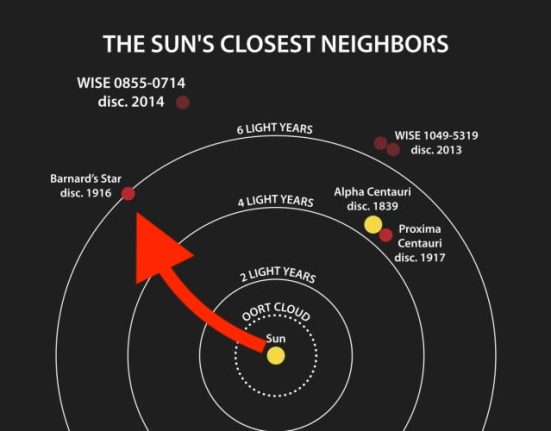
- WASP-107 b is a gas giant exoplanet about 210 light years from Earth. It is a little smaller than Jupiter, but much less massive.
- Its atmosphere is asymmetrical from east to west.. It is the first time that astronomers have detected such asymmetry in an exoplanet as it passes in front of its star.
- The planet is also “bloated”with an atmosphere much more inflated than it should be for the mass of the planet.
An exoplanet with a strange atmosphere
Astronomers have observed an exceptionally hot, inflated and asymmetric atmosphere. exoplanet using the James Webb Space Telescope. About 210 light years From Earth, WASP-107b is about 3/4 the size of Jupiter, but only a tenth of its mass. A team of researchers, led by the University of Arizona, saying on September 24, 2024, which has an east-west asymmetry in its atmosphere. It is the first time scientists have seen such asymmetry on an exoplanet while it is transiting his star. The planet also has a “puffy” atmosphere that is more inflated than usual for a planet of its mass.
the researchers published his peer reviewed findings in Nature Astronomy on September 24, 2024.
Webb observes WASP-107 b
Webb had observed WASP-107 b before and scientists knew its swollen atmosphere. For the most recent observations, the researchers used transmission spectroscopy. That is the analysis of light waves as they pass through the atmosphere. Basically, Webb followed the planet as it transited (passed in front of) its star, taking “snapshots” as the planet moved. This allowed Webb to analyze the planet's atmosphere. Main author Matthew Murphy at the University of Arizona saying:
These snapshots tell us a lot about the gases in the exoplanet's atmosphere, the clouds, the structure of the atmosphere, the chemistry, and how everything changes when receiving different amounts of sunlight.
Webb was able to take extremely precise measurements of WASP-107 b's atmosphere. Although the planet is still too far away to photograph, Webb examined the spectroscopic details of its western and eastern hemispheres.
Furthermore, WASP-107 b is also tide locked to his star. That means that one side of the planet always faces the star, much like how the same side of the moon always faces Earth. This creates a permanent day side and a permanent night side in WASP-107 b.
An asymmetrical atmosphere
Webb found something interesting: a east-west asymmetry. What is an east-west asymmetry? It is when there are differences in the atmosphere of a planet between its western and eastern hemispheres. For example, this may include temperature or other cloud characteristics, which distinguish the two hemispheres from each other.
In WASP-107 b, Webb found significant temperature differences between the morning and evening limbs. the paper fixed:
Instead, we infer a temperature difference between morning and afternoon of the order of 100 K with a warmer afternoon stretch.
In fact, this is the first time scientists have seen such asymmetry in an exoplanet as it transits its star. Murphy said:
This is the first time the east-west asymmetry of an exoplanet as it transits its star has been observed from space. I believe that observations made from space have many different advantages compared to observations made from Earth.
We don't have anything like it in our own solar system. It is unique, even among the exoplanet population.
On almost all exoplanets, we can't even look at them directly, much less know what is happening on one side or the other. For the first time, we can get a much more localized view of what's happening in an exoplanet's atmosphere.

A warm and mysterious world
Overall, WASP-107 b is a scorching world, with temperatures around 890 degrees Fahrenheit (750 K or 480 Celsius). That puts it between the coldest giant planets, like those in our own solar system, and exoplanets that are even hotter. The observations have raised many questions. The scientists didn't even expect to find the asymmetry they did. like murphy explained:
Traditionally, our observing techniques don't work as well for these intermediate planets, so there have been a lot of interesting open questions that we can finally begin to answer. For example, some of our models told us that a planet like WASP-107 b shouldn't have this asymmetry at all, so we're already learning something new.
Researchers are planning additional observations of WASP-107 b. This will help better understand the processes occurring in its atmosphere that make the planet so unique.
WASP-107 b is one of the least dense exoplanets found so far. It also has much less methane in its atmosphere than astronomers thought. This suggests that WASP-107 b is hotter inside and has a larger core than astronomers expected. Further, tidal warming It is probably causing this, which explains the swelling of the planet. The gravitational pull of the star is greater when the planet is closer and less when it is farther away. This causes it to stretch towards the interior of the planet, warming it in the process.
Bottom line: New observations by the Webb Space Telescope show that the giant exoplanet WASP-107 b has an asymmetric atmosphere between its western and eastern hemispheres.
Read more: Webb solves the mystery of puffy exoplanet WASP-107 b
Read more: The climate of exoplanet WASP-43 b is hot and wild












Leave feedback about this